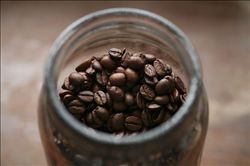Boutique coffee Salvadoran coffee origin Salvadoran coffee practice
Costa Rica's high latitudes produce coffee beans famous in the world, rich, mild taste, but extremely acidic, coffee beans here are
coffee beans
coffee beans
After careful processing, it is precisely because of this that there is a high quality coffee. Tarasu, south of San José, Costa Rica's capital, is one of the country's most prized coffee plantations. Tarrazu is one of the world's leading coffee producers.
History Edit
Coffee is an important source of income for Costa Rica, introduced in 1808 and cultivated for 200 years. Costa Rica has a third of the population invested
Newly developed villa sarchi species
Newly developed villa sarchi species
Coffee has changed the country, Costa Ricans say, and coffee has made an outstanding contribution to its rich environment. Although Costa Rica ranks third from the bottom in terms of land area in Central America, its economic environment is better than half of that of other countries. Because of its rich people and stable society, Costa Rica has more than 30 national parks.
Coffee was introduced to Costa Rica from Cuba in 1729, and today its coffee industry is one of the most well-organized in the world, producing up to 1700 kilograms per hectare. Costa Rica has a population of 3.5 million, but coffee trees number 400 million, and coffee exports account for 25% of the country's total exports. Costa Rica's volcanic soils are fertile and well drained, especially in the Central Plateau, where the soil consists of successive layers of ash and dust. Costa Rica was thus the first country in Central America to grow coffee and bananas for commercial value. Coffee and bananas are the country's main exports.
Scientific planting editor
Located about 30 kilometers northeast of San Jose, Costa Rica's capital, the research center is part of the Costa Rican Coffee Association, the country's national coffee association.
Brazil coffee fruit
Brazil coffee fruit
Coffee planting, breeding, quality inspection research institutions, in addition to it also has 10 hectares of experimental fields, planted with a number of excellent varieties. Coffee is Costa Rica's main agricultural product, with an annual output of more than 2 million bags (60 kg) and an export earnings of 250 million US dollars, second only to pineapples and bananas.
In Costa Rica, Arabica coffee trees are grown, improved, the quality of coffee beans is better and more stable; in order to facilitate picking, coffee trees are continuously pruned to maintain a height of about 2 meters; people eat coffee is the fruit of the seeds released by water brewing flavor. After picking the green coffee beans, the seeds (i.e. coffee beans) can only be roasted after removing the peel, pulp, seed membrane and sunlight exposure. Some processes can be replaced by machines, which increases the speed of coffee production. However, there is no machine to pick coffee, so manual work must be used.
Feature editor
Costa Rican coffee is full of particles, with ideal acidity and unique aroma. Costa Rica's coffee industry, formerly controlled by the Instituto del Café de Costa Rica (ICAFE), has been taken over by the Official Coffee Council (Oficin del Café). Among coffee exports, those deemed substandard are colored with blue vegetable dye before being recycled for domestic sale. Coffee consumed domestically (dyed blue or undyed) accounts for about 10% of total production, and local coffee consumption per capita is twice that of Italy or the United States.
This coffee producer, all grades and varieties, accounts for one-third of global consumption and a share of the global coffee market.
made in
made in
Although Costa Rica faces natural disasters several times higher than other regions, its arable area is enough to compensate.
There are many kinds of coffee here, but its industrial policy is large and cheap, so there are not many excellent coffee, but it is a good choice to mix other coffees.
One of the most famous is Mountain Costa Coffee, which tastes mellow and neutral. It can be boiled directly or mixed with other kinds of coffee beans. It is also a good choice.
Other types of Brazilian coffee, such as Rio, Parana, etc., can be produced in large quantities without too much care. Although the taste is rough, it is a kind of inexpensive coffee. Due to its distribution in all parts of the country, the solid quality varies, and there are its own standards (NO.2~NO.8 according to the number of impurities, NO.13~NO.19 according to the size of beans, divided into six grades according to taste). Almost all Arabica varieties are of good quality and stable prices, the most famous being Costa Rica, which has been a necessity for blended coffee since ancient times and is familiar to the public.
Excellent Costa Rican coffee is known as "extra hard beans" and can grow at altitudes above 1500 meters. Altitude has always been a problem for coffee growers. The higher the altitude, the better the beans, not only because higher altitudes increase the acidity of the beans and thus enhance the flavor, but also because the lower night temperatures at higher altitudes can slow down the growth of trees and thus enhance the flavor of the beans. In addition, due to the high altitude drop caused by sufficient rainfall, coffee tree growth is very favorable.
Costa Rican coffee is all Arabica beans, washed, it is bright style, full of aroma, clear as wind chimes in the breeze, and mild acid, sweet quite good. Because of the sweet taste, even if the coffee is cold, it is also very good to drink, which is a major feature of Costa Rica coffee. Therefore, it is recommended that you taste Costa Rican coffee with only a small amount of sugar and creamer in order to enjoy its girlish pure flavor.
Origin Editor
Tarasu
Tarasu, Costa Rica (T
made in
made in
Arazu) is one of the world's major coffee producing areas, producing coffee flavor pure light, pleasant aroma. Costa Rica's volcanic soils are fertile and well drained, making it the first country in Central America to grow coffee and bananas for commercial value. Coffee and bananas are the country's main exports.
extra hard bean
High-quality Costa Rican coffee is known as "extra-hard" and can be grown at altitudes above 1500 meters. Altitude has always been a problem for coffee growers. In addition, due to the high altitude drop caused by sufficient rainfall, the growth of coffee trees is also very favorable. However, although coffee is grown at higher altitudes,
Costa Rica
Costa Rica
Many advantages, but must take into account the additional transportation costs, which is likely to make coffee production unprofitable. Costa Rican coffee has adopted new technologies to increase efficiency, including the use of "electric eyes" to select beans and identify beans of irregular size.
Tarasu, located south of the capital San José, is one of the country's most valued coffee plantations. La Minita Tarrazu coffee is locally famous but produced in limited quantities, about 72600 kilograms a year, on land called La Minita, owned by nearly three generations of the McAlpine family in Britain. In fact, the land produces more than 450 tons of coffee per year. But Tarasulamita coffee is grown without artificial fertilizers or pesticides, and is harvested and picked entirely by hand, in order to avoid some of the damage done to the beans by air-jet sorting.
other varieties
Other coffees worth mentioning are Juan Vinas (PR), H.Tournon, Windmill (SHB), Montebello and Santa Rosa. Fine coffee is grown in Geredia and the Central Valley. Another striking coffee is Sarchi (one of five towns that represent Costa Rica's "coffee route"), which grows on the slopes of Poas Volcano, 53 kilometers from San Jose. Saatchi was founded in 1949 and has 30770 hectares of land to grow sugar cane and coffee. The area is also known for its handicrafts, attracting tourists from all over the world.

Important Notice :
前街咖啡 FrontStreet Coffee has moved to new addredd:
FrontStreet Coffee Address: 315,Donghua East Road,GuangZhou
Tel:020 38364473
- Prev

Boutique coffee Salvadoran coffee introduces the characteristics of Salvadoran coffee
Unique, mild-tasting coffee. ElSalvador is one of the small countries in Central America with a dense population. The flavor of its coffee is characterized by excellent balance. Today, this coffee accounts for 40% of the country's exports. 35% of the extra hard beans of the best coffee are exported to Germany from January to March. In the early 1990s, guerrilla warfare greatly damaged the country's national classics.
- Next

Boutique Coffee El Salvador Coffee Manor
Salvadoran coffee refers to the coffee produced in the small South American country of El Salvador, where the coffee body is light, aromatic, pure, slightly sour, the flavor is extremely balanced, is a specialty of Central America. With sour, bitter, sweet and other taste characteristics, the best baking degree is moderate, deep. Salvadoran coffee is characterized by balanced taste, good texture, sour, bitter and sweet taste.
Related
- Does Rose Summer choose Blue, Green or Red? Detailed explanation of Rose Summer Coffee plots and Classification in Panamanian Jade Manor
- What is the difference between the origin, producing area, processing plant, cooperative and manor of coffee beans?
- How fine does the espresso powder fit? how to grind the espresso?
- Sca coffee roasting degree color card coffee roasting degree 8 roasting color values what do you mean?
- The practice of lattes: how to make lattes at home
- Introduction to Indonesian Fine Coffee beans-- Java Coffee producing area of Indonesian Arabica Coffee
- How much will the flavor of light and medium roasted rose summer be expressed? What baking level is rose summer suitable for?
- Introduction to the characteristics of washing, sun-drying or wet-planing coffee commonly used in Mantenin, Indonesia
- Price characteristics of Arabica Coffee Bean Starbucks introduction to Manning Coffee Bean Taste producing area Variety Manor
- What is the authentic Yega flavor? What are the flavor characteristics of the really excellent Yejasuffi coffee beans?

